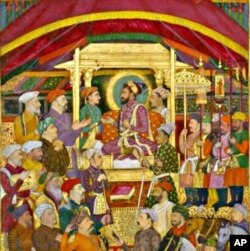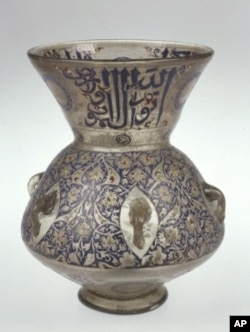Islam has spread to cultures and regions far beyond its birthplace on the Arabian peninsula. Among its traditions is the value placed on gift giving These gifts, from over the centuries, are works of art which often bear motifs associated with Islam.
That Muslim tradition of gift giving is the focus of an exhibit at the Museum of Fine Arts in Houston.
The theme of the exhibit, which bears works ranging from the 8th to the 19th centuries, is in its title: “Gifts of the Sultan: The Art of Giving at the Islamic Courts.”
Curator Francesca Leoni says every piece on display reflects that concept. “This exhibition uses gift exchange as the framework.”
A decorative plate at the entrance is inscribed with a verse from the Koran; ”He who believes in recompense from God is generous with gifts.”
According to Leoni, gift giving has special meaning in the Muslim world. “In the Islamic world, generosity has always been a very important value. It was sort of a profound ethical duty to share things with the ones in need.”
Many of the finest items on display were gifts given for political reasons. An ink-and-gold depiction of an Indian mogul receiving an ambassador from Persia in the 17th century is owned by Queen Elizabeth II.
The museum says Islam represented itself to outsiders through the exchange of gifts, whether the purpose was personal, political or pious.
A finely-crafted backgammon set, painted ceramic tiles and tapestries are also among the gifts on display. Many items feature arabesques and geometric patterns because Islam discourages the depiction of humans and animals.
“There is the ubiquitous use of geometry and geometric patterns from Spain to central Asia and Indonesia," says Leoni. "Then each one of these countries gives its own input and twist.”
Karen White came to see the show and was impressed by the richness of these works. “I am astounded at the detail, the different colors.”
According to Leoni, Arabic calligraphy influenced artists far from the Arabian peninsula, who came to know the language through the sacred writings of the Quran.
“The transformation of language, of a beautiful script into writing, is really associated with the importance that the written word has had in Islam from the very beginning.”
For people from Muslim countries, transforming the written word into art is familiar.
“It is striking to the eye, and that definitely helped propagate the religion as a whole, because once you mix religion and art and you do it beautifully, you allow the religion to grow,” says Farajin, another visitor to the museum.
Some of the objects remind Houston resident Cyrus Mayeh of his childhood in Iran. “Especially looking at the carpets, Persian carpets, and I could feel sitting on those carpets and that is a special feeling that I get from it.”
That feeling of wonder is the enduring legacy of the works of art on display. Even centuries after they were first given as gifts, the pieces continue to inspire and give pleasure to those who view them.












